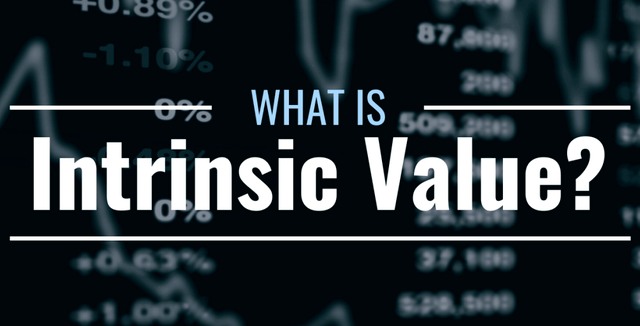
What is Intrinsic Value?
Intrinsic value or Intrinsic Valuation involves predicting cash flows from the present to eternity and then discounting them using the expected cost of capital. This yields the present value, which represents the essence of an asset's or investment's worth. Intrinsic value signifies the foundational or genuine value of an asset, investment, or company. This estimation derives from unbiased elements like cash flows, earnings potential, growth trajectory, investments and risk analysis. It serves to appraise whether an asset is adequately priced relative to its present market value. This concept holds significant importance in numerous financial and investment valuations, guiding decisions surrounding the purchase, sale, or retention of assets.
Discounted cash flows serve as a cornerstone in the determination of intrinsic valuation. These cash flows are divided into two components:
- Cash flows anticipated during the projected period
- Cash flows extending beyond the forecasted period (Terminal Period).
Understanding Intrinsic Value or Intrinsic Valuation
The cash flows generated during these periods belong to Lenders (Debt) and Shareholders. The present value of these cash flows is called the Enterprise Value. The Enterprise Value less Debt will be called Shareholder Value of the Company / Business. Therefore:
- Enterprise Value = Intrinsic Value (Shareholder Value) + Debt Value (includes all interest bearing obligations).
- Intrinsic Value = Enterprise Value – Debt (Further the Company’s Statement Of Affairs may also contain Non-Operating Balance Sheet elements such as cash, securities, investments & other assets and minority interest & other liabilities that are not utilized for generating operating cash flows which may need to be added or subtracted to arrive at the Intrinsic Value or Shareholder Value).
- Intrinsic Value /Shareholder Value therefore is:
- The Present Value (PV) of Operating Cash Flows After Tax (operating profit less investments less tax) during the forecast period, plus
- Present Value of Terminal Value of the company’s business. (The value of cash flows generated post the forecast period, plus
- Cash & Marketable Securities and other investments (The income from these investments should not be included in cash flows from operations), minus
- Minority Interest and Other Liabilities, minus
- Debt and Long-Term Obligations
Cash flow from operations is operating cash inflows less operating cash outflows. Cash inflows is operating profit and cash outflows is fixed assets investments, net working capital (NWC) investments and income tax.
The cash flow from operations is estimated for each year in the forecast period, which is then discounted back to the present. The cost of capital or the Weighted Average of the Cost of Debt Capital and Cost of Equity Capital (WACC) is used to discount the cash flows. The Present Value of Terminal Value is the cash flow in steady terms (real terms) post the forecast period to perpetuity, discounted back to the present.
Key take Aways of Intrinsic Value

- Intrinsic value predicts cash flows from present to eternity, discounted by cost of capital.
- Represents core value of assets, investments, or companies based on unbiased factors.
- Assesses if asset's price aligns with market value, crucial for financial and investment decisions.
- Discounted cash flows are key, split into projected period and terminal period.
- Enterprise Value = Intrinsic Value + Debt Value
- Intrinsic value or Shareholder Value = Enterprise Value - Debt
- Intrinsic Value = PV of operating cash flows + PV of terminal value of business.
- Cash flows involve lenders (debt) and shareholders, cash flow from operations.
- Calculation uses WACC, discounts cash flows from forecast period and terminal value.
Calculation of Intrinsic Valuation
Table 1 demonstrates the computation of the Present Value of Cash Flows for a forecast period of 5 years with a discount rate of 11% and the present value of terminal value.
Table 1
| Year | 1 | 2 | 3 | 4 | 5 |
| Cash Flow | 1000 | 1500 | 2000 | 2500 | 3000 |
| 11% Discount Factor | 0.901 | 0.812 | 0.731 | 0.659 | 0.593 |
| Present Value of Cash Flow | 900.90 | 1217.40 | 1462.40 | 1646.80 | 1780.40 |
| Cumulative PV of Cash Flow | 900.90 | 2118.30 | 3580.7 | 5227.50 | 7007.90 |
| Inflation | 2% | ||||
| WACC | 11% | ||||
| Discount Factor | 1/(1.11)n |
| Cumulative Present Value of Cash Flow | 7007 |
| Present Value of Terminal Value | 20178 |
| Debt & Obligations | 1000 |
| Intrinsic Value | 26185 |
Notes:
- The computation of terminal values assumes there will be only inflationary growth in cash flows.
- The computation of terminal value will be explained in Chapter 18 of The Art of Valuation book.
- Readers should read Chapter 4 - Time Value of Money and Discount Factor for better understanding of discounting and terminal value.
Dividend discount Model and Intrinsic Valuation
The Dividend Discount Model (DDM) is also a intrinsic valuation method used to estimate the intrinsic value of a stock based on its expected future dividend payments. It is a popular approach among income-oriented investors who prioritize the cash flow generated by dividends.
The DDM is based on the principle that the value of a stock is the present value of all its expected future dividends. It assumes that dividends are the primary source of returns for investors and that dividends will grow at a constant rate over time.
There are different variations of the Dividend Discount Model, but the most common form is the Gordon Growth Model, also known as the Gordon-Shapiro Model. The Gordon Growth Model assumes a constant dividend growth rate (g) and a required rate of return (r) for the investors.
The formula for the Gordon Growth Model is as follows:
Intrinsic Value (V) = D1 / (r - g)
Where:
V = Intrinsic value of the stock
D1 = Expected dividend per share in the next period (usually the next year)
r = Required rate of return or discount rate (the return investors expect to earn for holding the stock, often referred to as the cost of equity)
g = Growth rate of dividends (the expected annual rate at which dividends are expected to grow in the future)
The constant growth rate (g) is a critical assumption in the Gordon Growth Model. For the model to be valid, the growth rate must be lower than the required rate of return (r). If the growth rate is equal to or greater than the required rate of return, the model cannot be used, as it would result in a negative intrinsic value, which is not meaningful.
Limitations of the Dividend Discount Model
- Assumes Constant Growth: The model assumes that dividends will grow at a constant rate indefinitely, which may not be realistic for all companies.
- Ignores Non-Dividend Cash Flows: The DDM only considers dividend payments and ignores other forms of cash flows, such as share buybacks or reinvested earnings.
- Sensitivity to Assumptions: The intrinsic value calculated using the DDM is sensitive to changes in the growth rate and required rate of return, making the valuation subject to uncertainties in these assumptions.
Despite its limitations, the Dividend Discount Model can provide valuable insights for investors who focus on dividend income and want to assess the fair value of dividend-paying stocks. It is essential to complement the DDM with other valuation methods and consider qualitative factors when making investment decisions.
Frequently Asked Questions

What is Residual Income Valuation and its relation to Intrinsic Valuation
Residual income is a financial metric used to assess the value a company generates above its required rate of return. It's calculated by subtracting the cost of equity capital from the net income. Residual income provides insight into whether a company is creating value beyond what investors expect.
Intrinsic valuation on the other hand, refers to the true worth of an asset or investment based on factors like cash flows, growth potential, and risk assessment. It's used to determine whether an asset is overvalued or undervalued compared to its market price.
Residual income can be a component of intrinsic value analysis, helping to determine if a company's current earnings are generating value beyond the cost of capital. Both concepts play roles in investment assessment, with intrinsic value providing a broader perspective on overall asset valuation.
Why ‘Intrinsic Value Matters
Intrinsic value is a fundamental concept in finance and investing that represents the true or inherent worth of an asset, such as a stock, bond, or company. It matters for several key reasons:
- Investment Decisions: Intrinsic value is used by investors to determine whether an asset is undervalued, overvalued, or fairly priced in the market. If the intrinsic value is higher than the current market price, it suggests that the asset may be undervalued and could potentially be a good investment opportunity. Conversely, if the intrinsic value is lower than the market price, it may indicate that the asset is overvalued and not a favourable investment choice.
- Informed Decision-Making: Understanding the intrinsic value of an asset provides investors with a basis ozr making well-informed investment decisions. It helps investors avoid making emotional or speculative choices based solely on short-term market fluctuations.
- Long-Term Perspective: Focusing on intrinsic value encourages a long-term investment horizon. Instead of chasing short-term price movements, investors assess the underlying value of an asset, which aligns with the principles of value investing.
- Risk Management: By considering intrinsic value, investors can better assess the risk associated with an investment. If an asset is significantly overvalued compared to its intrinsic value, there is a higher risk of a price correction or a potential market bubble.
- Valuation and Fairness: Intrinsic value is crucial in valuation exercises, mergers and acquisitions, and negotiations. It serves as a benchmark for determining a fair price for buying or selling assets, companies, or entire businesses.
- Business Evaluation: Intrinsic value is valuable in assessing the health and potential of a company. Investors and analysts use various valuation methods to estimate the intrinsic value of a company's stock, which helps in evaluating its financial performance and growth prospects.
- Avoiding Speculative Bubbles: Intrinsic value analysis can help investors avoid participating in speculative bubbles where asset prices become detached from their true worth. Recognizing when an asset's price is significantly above its intrinsic value can serve as a warning sign to exercise caution.
- Risk-Reward Balance: By considering intrinsic value, investors can weigh the potential rewards of an investment against its risks. A well-calculated intrinsic value can provide a clearer picture of the risk-reward balance.
In summary, intrinsic value matters because it provides a foundation for rational decision-making, guides investment choices, and helps investors identify potential opportunities and risks. It promotes a disciplined and analytical approach to investing, supporting a long-term and value-focused investment strategy.
